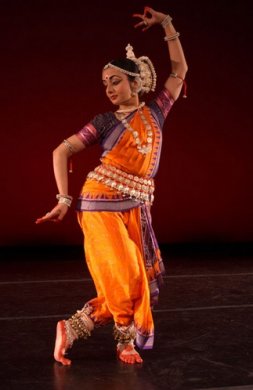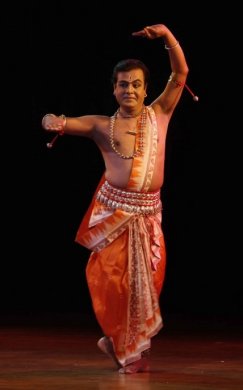
|   |

|   |
Chayanika - Nita Vidyarthi e-mail: nitavidyarthi@gmail.com February 17, 2015 ‘Chayanika,’ an evening of classical dance, was presented by Srishti Dances of India (USA) and Rajib Bhattacharya at ICCR’s Satyajit Ray Auditorium in Kolkata, showcasing Bharatanatyam, Odissi, and Gaudiya Nritya by Gaudiya Nritya Bharati. US based Odissi and Bharatanatyam dancer Sreyashi Dey and her group opened the evening with an interesting Odissi-Bharatanatyam collaborative choreographic work where the lyrical grace and fluidity of Odissi complemented the elegance and geometry of energetic Bharatanatyam within the same tala frame, while maintaining the individuality of each idiom. An impactful invocation “Omkara Karini” for the great goddess Tripura Sundari with 3 Odissi and 3 Bharatanatyam dancers showed good training of the dancers and fine coordination between the two groups. The Bharatanatyam dancers displayed better maturity and understanding than the Odissi trio. Sreyashi, trained in Odissi with Guru Gangadhar Pradhan and in Bharatanatyam with Guru Saroja Vaidyanathan, is a seasoned dancer but her solo Odia abhinaya “Manini” where she enacts Radha lacked adequate emotions to express the rasa and the bhava in “Kahiki nahi more kunjaku Shyam nagar.” Both Pallavi in Odissi and Tillana in Bharatanatyam is a test of the technical and rhythmic competence of a dancer and this capacity was well explored in the parallel styles embracing raga Shankarabharanam and Arabhi respectively with significantly common identity of rhythmic joy. The piece was well choreographed by Sreyashi with three dancers from each group performing in their respective styles with a final presentation combining the elements of the two forms. However, the Bharatanatyam dancers were undoubtedly more confident and stronger. The concluding ‘Dasavatar’ had some fine formations and freezes with the different avatars being performed in turns in each style individually and was an encouraging attempt for Sreyashi and her US based troupe.  Sreyashi Dey  Rajib Bhattacharya (Photo: Arabinda Mahapatra) Gaudiya Nritya Bharati’s invocation “Ganesh vandana” in Jhaptaal from Annadamangal Kabya by three dancers under the supervision of Professor Mahua Mukherjee was mediocre followed by “Ardhanariswar” in raga Bilawal and Malkauns, tala tewda by senior dancer Shatabdi Acharya. Shatabdi is a strong dancer but her presentation was highly aggressive. This was fine with the tandava aspect, but the lasya component suffered heavily. Her height and presence added to the aggression as a result of which the energetic dancing tarnished the rasanubhuti. The real success of any dancer is to transmit to the audience the essence and aesthetics of the presentation and in this case it was hardly achieved. On the contrary, Rajib Bhattacharya and the members of Srijan Chhanda offered ‘Tridhara,’ a beautiful bouquet of Odissi with glimpses of the three gharanas of the three legendary gurus of Odissi. It was a “Triveni tirtha” with Odissi being set to the melodic songs of Rabindranath Tagore. Beginning with the mahari / devadasi style of Guru Pankajcharan Das, a group of well trained young dancers in mahari costume of royal blue and shocking pink with the characteristic head ornament Phula Tahia presented a vibrant pure dance item set to Tagore’s “Prathama adi tobo Shakti.” The surphaktaal (10 beats) based number in raga Sohini has hardly been seen choreographed in Odissi, the taal pattern being modified to Ektaali. Rajib Bhattacharya’s solo Desh Pallavi in Guru Kelucharan Mohapatra style set to “Esho shyamal sundaro” in raag Desh (original teentaal) presented in adi tala with the interludes of Taajhum taritajhenu came as a wonderful surprise and the blend was highly rewarding. With Guru Ratikant Mohapatra’s mardal and music composition, the Tagore number had an innovative dimension. Rajib has evolved not only as a fine dancer but also as a mature and competent choreographer. The final “Bipulo Taranga re,” a Bhipalasi, tewda taal Rabindrasangeet was a group number set to taal jhampa in the Debaprasad style, with interludes of the original song “Nachata tribhanga re” combining all three Odissi styles. A lot of hard work and research has gone into this meaningful production, especially the effort to maintain the respective styles and the appropriate costumes. Popular vocal accompanist Debashish Sarkar, known for his classical raga-based songs surprised with his soulful renditions of Rabindrasangeet. The script by Seema Mukherjee, sitar by Jayanta Chakraborty and mardal by Ratikant Mohapatra, though recorded, made the piece enjoyable. The video screening on the backdrop illustrating the contents of the songs were subtle expressions of the lyrics enhancing the appeal of the numbers. The attempt was definitely praiseworthy. Dr. Nita Vidyarthi is a critic of performing arts, specialising in dance, dance theatre and expressions and is a regular contributor to The Hindu, and the Statesman Kolkata in dance, vocal music and theatre. She is trained in Kathak, Bharatanatyam and Manipuri as well as vocal, semi-classical music and Rabindra Sangeet. |